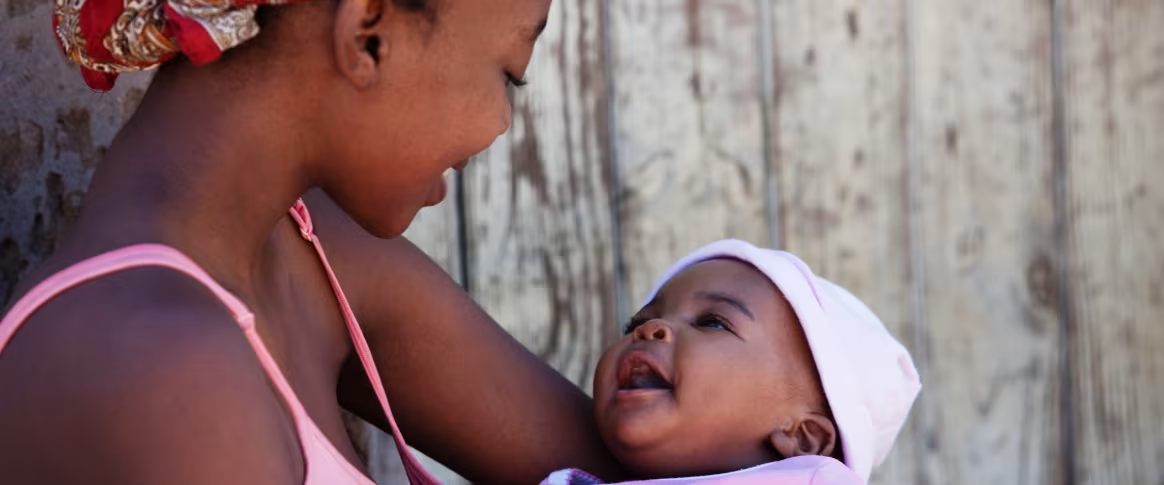The maternity risk wheel: Enhancing outcomes for mothers and babies
LBS research improving the odds for newborns and mothers in Sub-Saharan Africa
Please enter a keyword and click the arrow to search the site
Or explore one of the areas below

Infant mortality rates have almost halved globally since 2020. In 2023, UNICEF reported 4.9 million deaths among children under the age of five; a significant improvement on the five million deaths reported the year before. Dig a little deeper into the data, however, and persistent and entrenched inequities emerge.
Among children who died before their fifth birthday last year, 57% were born in Sub-Saharan Africa—this despite the region accounting for just 30% of all live births globally. The World Health Organization has also flagged “stark disparities” in the quality of maternal healthcare, reporting that one woman died every two minutes because of pregnancy or childbirth complications in 2023.
Deaths among children under the age of five in 2023
Were born in Sub-Saharan Africa
Babies and mothers require quality care in the periods before, during and immediately after birth. The WHO finds that most children who die within the first month of life suffer from conditions and diseases—prematurity, birth complications, neonatal infections, and congenital anomalies—that could be successfully treated by skilled practitioners. When women receive care from midwives and health professionals in well-resourced facilities, says the WHO, they are 16% less likely to lose their babies and 24% less likely to experience a pre-term birth.
In rural parts of Sub-Saharan Africa, where maternal and infant mortality rates are highest, Maternity Waiting Homes may offer a simple and effective solution: the idea is for the most isolated and vulnerable expecting mothers to temporarily move to a residential facility run by a midwife and close to a clinic, instead of waiting for the birth at home. With some research suggesting that this may reduce maternal deaths and stillbirths by up to 80% and 70% respectively, these facilities are seeing significant traction in countries like Liberia, Zambia, Zimbabwe, Eritrea and Ethiopia.
But challenges remain. Despite their clear benefits, only 54% of eligible women end up using Maternity Waiting Homes, and in some regions these facilities are dangerously overcrowded —a consequence of inadequate logistical and resource allocation planning. Complicating factors include a lack of clarity on:
Addressing these issues calls for logistical expertise. Finding solutions at cost and scale in this region also requires creative operational and procedural thinking—the kind of thinking that undergirds a growing body of work led by Jérémie Gallien, Professor of Management Science and Operations at London Business School. Jérémie is an expert in supply chain management and optimisation. His research harnesses supply chain science and mathematical modelling to improve efficiency in healthcare delivery system, inventory control and distribution mechanisms, particularly in underserved and marginalised communities.
Jérémie’s most recent work, with his LBS colleague George Chen and their PhD student Yuhang Du, has brought him into collaboration with the Ministry of Health of Liberia (Bentoe Tehoungue), the University of Liberia (Joseph Sieka) and the University of Michigan’s School of Nursing (Jody Lori). It could be poised to deliver life-changing impact to expectant mothers and new-born babies in need to skilled healthcare support and facilities in West Africa and beyond.
For a pregnant woman, knowing exactly when to make the journey to a Maternity Waiting Home is contingent on understanding a range of variables, among them the location of the nearest facility and ease and speed of access; local infrastructure and seasonal conditions; and how long labour takes to progress from the latent to the active phase, when clinical care becomes critical. Calculating these variables can be huge challenge for women living in rural or remote locations, with little recourse to systematic advice or guidance.
To address this, Jérémie and his collaborators have developed a simple cost-effective device that leverages mathematical analysis to calculate the risk that a mother will start the active phase of her labour without a skilled birth assistant being present. The device, a wheel with concentric dials displaying the estimated time it will take to access a facility, arrival times and length of stay. It can be used by health professionals to help pregnant women make better-informed decisions about antenatal care arrangements based on individual risk, which is different for nulliparous (first-time) and multiparous mothers for example.
The wheel can also calculate the extent to which risk is reduced depending on how soon a labouring woman is admitted into a Maternity Waiting Home.
Jérémie describes the mathematical modelling that undergirds his maternity risk wheel as “basic.” Nonetheless, its usability and potential efficacy in clinical contexts where resources and access to internet can be limited have prompted Jérémie’s collaborators in Liberia to initiate a pilot test there. They have also secured a contract with a Chinese company to manufacture the wheel at scale for distribution to clinics across rural Liberia.
A second tranche of Jérémie’s work in Liberia is focused on enhancing decision-making at a centralised level. With George Chen and Yuhang Du, he has developed a mathematical model and mapping tool to maximise the positive health impact of Maternity Waiting Homes on populations in rural areas by leveraging a slew of variables, including demographics, geographical location, and travel times for pregnant women to the nearest facility.
Their model processes all this data to give policymakers a clearer understanding of the different levels of need or demand per location, the number of beds available, and the risks to pregnant women in not getting to skilled care in time for assisted deliveries. Armed with these simplified insights, decision-makers are better equipped to make informed choices on capacity decisions, staffing and travel advice for pregnant women.
Working with Jérémie, George Chen and Yuhang Du, LBS alum Dimitris Panayiotou is leading the development of a free open-source web application built on their model that enables policymakers and healthcare providers to input local data and generate heat-map visualisations and tailored recommendations—resources that should help significantly reduce the volume and likelihood of unassisted births and therefore infant mortality in rural Liberia, and potentially beyond.
Jérémie Gallien is leading research that leverages mathematical modelling used in supply chain optimisation to bring urgently needed, cost-efficient and potentially impactful solutions to the needs of the some of the most vulnerable populations on the planet.
His work in addressing neonatal and maternal mortality in Liberia brings together the expertise—much of it volunteered—of diverse colleagues and collaborators from academia, government, and business to restack some of the odds faced by disadvantaged women and children in marginalised communities in one of the world’s poorest and least developed economy.
While Liberia occupies something of a forefront in terms of infant mortality and the use of Maternity Waiting Homes in Sub-Saharan Africa, Jérémie sees his work there as a “test bed” in which to develop, deploy and measure the impact of simple but effective interventions that can be replicated across the entire region and beyond. It is work that he hopes will contribute to the success of United Nations Sustainable Development Goal 3, which calls for a reduction in the unacceptably high maternal mortality ratio in the world’s lowest income regions: from 531 per 100,000 live births down to 70 per 100,000 by 2030.
Maximising impact where the need is greatest is a catalyst for this work, and for much of his extensive body of research; research that has received continuous support from LBS colleagues, students, alumni and the Wheeler Institute over the years, he says.
Jérémie is the author of a number of research papers that address healthcare problems in developing economies. One study uses supply chain science to solve inefficiencies in the distribution of malaria drugs in Zambia. A pilot associated with the research has led to a new medicine inventory system, eZICS, administered by the Zambian Ministry of Health, IBM, the World Bank and others; a breakthrough that has seen Jérémie’s work hailed by USAID as a “benchmark… for conceptualising the management of seasonal commodities in Zambia.” Other papers look, for instance, at the efficacy of vaccines that have been diluted to amplify reach in underserved communities, or the optimal location of laboratories to diagnose HIV in infants.
Jérémie’s work in applying tested mathematical techniques to global health systems is creating real-world impact where need is greatest, but the insights that it yields also enrich knowledge development around healthcare in emerging economies—an area of growing appeal and interest for upcoming generations of business students and practitioners.
At London Business School, the Managing Healthcare elective that Jérémie teaches with his colleagues Nicos Savva and Kamalini Ramdas is very popular; a clear indication, he says, of an upswing of interest in the impact of knowledge for the developing world.
Our research is helping to solve some of society's most challenging questions and concerns.
Our faculty publish over 100 papers and articles every year, many of which are featured in top-ranked business journals. Discover what our researchers are working on and how they are shaping the world.

The study reveals that the motherhood penalty, characterised by reduced earnings opportunities in wage employment due to motherhood status, significantly drives female entrepreneurship, particularly among women facing wage discrimination, offering insights into women's career choices amidst workplace inequality.
LBS faculty: Olenka Kacperczyk

The research shows that judgments of hypocrisy are biased by social motivations, with people more likely to accuse enemies and defend allies based on how they perceive similarities in behaviour.
LBS faculty: Jonathan Berman

Research combining mathematical modelling with data from executive hiring, crowdfunding, and patent applications challenges the assumption that increasing the number of women in application pools will improve gender diversity.
LBS faculty: Isabel Fernandez-Mateo